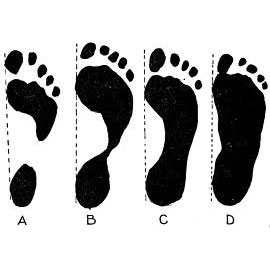Labor Day weekend is here and it is a perfect time to discover your foot type. Why now? The Shoe Lady most fervently hopes and recommends that you will be spending a significant portion of the weekend under sunny skies, near water and barefoot.
Get your bare feet wet. Now step on dry pavement. Which of the shapes below look most like your footprint? Why does it matter? There are 28 different “fit points” involved in building a pair of shoes. Length and width are only two of those 28. Understanding your foot’s shape will help you make better choices about the style of shoes to buy.
SHAPE A and B: High arches. Shape A has such high arches that the foot is raised off the ground even at the outside edge. Shape B has high arches with a narrow outer edge of the foot touching the ground. About 20% of the population have high arches. This type of foot tends to be a bit more rigid than other types.
Recommendation for selecting shoe styles for feet with high arches:
Imagine carrying your body weight on your heels and the balls of your feet with a delicate bridge of tiny bones, tendons and muscles holding the foot together in mid air. Are you feeling sorry for your feet? You should be! Treat them well. Think about that delicate bridge and do what you can to support it. Many shoes come with arch supports built in. The Propet brand includes removable arch supports in all it’s styles. Many other brands like Naturalizer, Ros Hommerson and Soft Spots include some styles with removable arch supports. The problem with arch supports is making sure that it fits the shape of the arch in your foot. Once you figure out how to support that arch, you will have a relatively wide selection of styles. If you need an arch support or orthotic all the time, you may be limited to styles that are closed and styles that can accommodate an orthotic insert.
While you are imagining your foot centered around a delicate bridge linking the ball and the heel, don’t forget to feel sorry for the ball and heel – left to carry the full weight of whatever you may be. Unless you are elfin thin, this can be hard work for the ball and heel of your foot. Think soft cushioning for them. Think about keeping them flat so they can share the burden of your weight. When you wear heels, more responsibility for carrying your weight goes to your toes and the balls of your feet. Ballet flats are a great choice. Even better if the inner or outer sole add cushioning.
SHAPE C: Average arches. Shape C is what shoe makers assume when they design a new shoe style. There is an arch, but not high.
Recommendation for selecting shoe styles for feet with average arches:
Pay attention to other aspects of your foot shape. But you are “home free” on the arch issue when it comes to picking styles!
SHAPE D: No arches. Shape D is a flat foot with little or no arches. About 20% to 30% of the population are born with flat feet. We can also get flat feet as we age, often as a result of obesity, hypertension or diabetes. Flat feet are normal and should not cause problems, unless there is an underlying condition that causes pain. (If there is pain involved, see a podiatrist or physical therapist for treatment, this is over The Shoe Lady’s pay grade!)
Recommendation for selecting shoe styles for feet with no arches:
One of the most annoying problems with buying shoes for flat feet is finding shoes that do not gap around the area of the arch. The best choices for flat feet are shoes with a high vamp and shoes with a mary jane style strap across the top of the foot. You will find many “granny” styles that fit this description. Keep in mind, dear young one, that your sense of style can convert that granny look to something hot with the right accessories. Think red mary jane’s and purple paisley knee socks. It doesn’t have to be dull. High vamp shoes also bring the two sides of the shoe together more and so will avoid the gapping problem with your shoes. A loafer is a typical high vamp shoe. Some other flats and pumps have higher vamps as part of their design. There are more straps, inserts, etc. A new “retro” style this season is the “smoker” flat. it has a high vamp. And, of course, lace ups and ankle boots are always good to close that gap.
Footnote on arches: There are two main arches in our feet. The long arch runs from the ball of the foot to the heel. The transversal arch runs under the ball of the foot. For more information, see this Wikipedia article.
Walk in comfort!
The Shoe Lady

